


<
>
PHOTONIC HYBRIDS AND NANOMATERIALS GROUP
Aveiro-Portugal
university of aveiro
theoria poiesis praxis
physics department
ciceco
aveiro institute of materials


HOME > SCIENTIFIC OUTPUT > PROJECTS > WINLED

Project Designation |
WINLEDs – Innovative, tunable and sustainable white light emitting diodes (LEDs)
Project code |
Main Objective |
Responsible Entity |
CENTRO-01-0145-FEDER-030351
Strengthening research, technological development and innovation
University of Aveiro (UA)

Starting date | 01-07-2018 Ending date | 30-06-2021
Total Cost |221 013.00€
ObjeCtivES
The recent advancement of light emitting diodes (LEDs) leads to the all-time fastest-growing of lighting industry. Nowadays, besides indoor and outdoor lighting, solid-state lighting (SSL) technology is also penetrating deeply into other market segments, such as automotive lighting, medical applications and also lifestyle products. The current challenges in SSL encompass high luminous efficiency, chromatic stability, high colour rending index (CRI), tuneable colour correlated temperature (CCT) and price competitiveness. Recently, the development of efficient and low-cost down-shifting photoluminescent phosphors for ultraviolet/blue to white light conversion was highly investigated. Here, we propose the development and characterisation of new LEDs prototypes, whose white light emission is characterised by better CRI and CCT values compared with those of the current commercial white LED, being a lighting solution closer to natural light. Here, we propose the development and characterisation of new LEDs prototypes, whose
white light emission is characterised by better CRI and CCT values compared with those of the current commercial white LED, being a lighting solution closer to natural light. To achieve this goal, two strategies will be followed, namely the development of new broad band emitting non-toxic organic-inorganic hybrid nanoparticles made from inexpensive, easily recyclable materials and RGB emitting lanthanide-based organic-inorganic hybrids processed as thin films. These hybrid materials will be deposited on the surface of commercial LEDs emitting ultraviolet radiation that will be absorbed and converted into high-brightness white light, high CRI (> 90) and tuneable CCT (3000-6500 K) mimicking the characteristics of sunlight along the solar day and in different seasons of the year. The ability to produce high CRI LEDs without complicated and costly processes is a major competitive and differentiating advantage in the SSL marketplace for lighting solutions with innovation, design and the quality demanded by today's lighting markets. This will contribute to the faster dissemination of LED technology in specialized areas such as displays or linked to interior and artistic design projects (eg cinema, photography, art galleries). In addition, the possibility of tuning the CCT of these new LEDs also potentiates its application in other areas, such as the control of the human circadian rhythm, of animals and plants, with an impact on the physiological state and the determination of patterns of brain activity and regeneration of lived-cells.
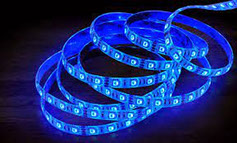
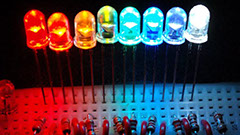
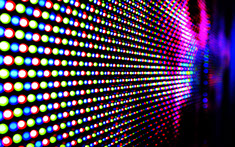
BOOK CHAPTERS
AR Bastos, PS André, LD Carlos, RAS Ferreira. Green photonics integrated circuits based on organic-inorganic hybrids., Book chapter from Nanocomposites for photonic and electronic applications. Chapter 9, Elsevier, (2020), em Sol-gel derived optical and photonic materials, edited by Elsevier, editores: Rui Almeida, Alex Martucci, L. Santos and Rocio Hernandez.
PAPERS
Ming Fang, Albano N. Carneiro Neto, Lianshe Fu, Rute A. S. Ferreira, Verónica de Zea Bermudez and L. D. Carlos, A hybrid materials approach for fabricating efficient WLEDs based on di-ureasils doped with carbon dots and a europium complex, Adv. Mater. Technol. 2021, 2100727, https://dx.doi.org/10.1002/admt.202100727.
Biju Francis, Mariela M. Nolasco, Paula Brandão, Rute A. S. Ferreira, Rafael S. Carvalho, Marco Cremona, and Luís D. Carlos, Efficient visible-light-excitable Eu3+ complexes for red organic light-emitting diodes, Eur. J. Inorg. Chem. 2020, 1260–1270, https://dx.doi.org/10.1002/ejic.202000027.
Ming Fang, Lianshe Fu, Sandra F. H. Correia, Rute A. S. Ferreira and Luís D. Carlos, Highly efficient luminescent polycarboxylate lanthanide complexes incorporated into di-ureasils by an in-situ sol-gel process, Polymers 2018, 10, 434, https://dx.doi.org/10.3390/polym10040434.
Ming Fang, Lianshe Fu, Rute A. S. Ferreira and Luís D. Carlos, White-light emitting di-ureasil hybrids, Materials 2018, 11, 2246, https://dx.doi.org/10.3390/ma11112246.
Airton G. Bispo-Jr, Sergio A. M. Lima, Luís D. Carlos, Ana M. Pires, and Rute A. S. Ferreira, Eu(II)-activated silicates for UV light-emitting diodes tuning into warm white light, Adv. Eng. Mater. 2020, 22, 2000422, https://dx.doi.org/10.1002/adem.202000422.
Shikao Shi, Lina Wang, Ming Fang, Lianshe Fu, Luís D. Carlos, Rute A. S. Ferreira, Jiye Wang, Shuping Wang, Blue-light excitable La2Ce2O7:Eu3+ red phosphors for white light-emitting diodes, J. Alloys Compd. 2020, 814, 152226, https://dx.doi.org/10.1016/j.jallcom.2019.152226.
Airton G. Bispo-Jr, Sergio A. M. Lima, Luís D. Carlos, Rute A. S. Ferreira, and Ana M. Pires, Red-emitting coatings for multifunctional UV/red emitting LEDs applied in plant circadian rhythm control, ECS J. Solid State Sci. Technol. 2020, 9, 016008, https://dx.doi.org/10.1149/2.0122001JSS.
Airton G. Bispo-Jr, Sergio A. M. Lima, Luís D. Carlos, Rute A. S. Ferreira, Ana M. Pires, Phosphor-based green-emitting coatings for circadian lighting, J. Lumin. 2020, 224, 117298, https://dx.doi.org/10.1016/j.jlumin.2020.117298.
Sandra F. H. Correia, Ricardo L. Fernandes, Lianshe Fu, Mariela M. Nolasco, Luís D. Carlos, and Rute A. S. Ferreira, High emission quantum yield Tb3+‐activated organic‐inorganic hybrids for UV‐down‐shifting green light‐emitting diodes, Eur. J. Inorg. Chem. 2020, (18), 1736–1742, https://dx.doi.org/10.1002/ejic.202000054.
Ming Fang, Airton G. Bispo-Jr, Lianshe Fu, Rute A.S. Ferreira, Luís D. Carlos, Efficient green-emitting Tb-doped di-ureasil coating phosphors for near-UV excited light-emitting diodes, J. Lumin. 2020, 219, 116910, https://dx.doi.org/10.1016/j.jlumin.2019.116910.
Thays C. F. Santos, Rebeca R. Rodrigues, Sandra F. H. Correia, Luís D. Carlos, Rute A. S. Ferreira, Celso Molina, Laura O. Péres, UV-converting blue-emitting polyfluorene-based organic-inorganic hybrids for solid state lighting, Polymer 2019, 174, 109–113, https://dx.doi.org/10.1016/j.polymer.2019.04.042.
A. R. Bastos, B. McKenna, T. Silvério, L. D. Carlos, P. S. André, R. C. Evans, & R. A. S. Ferreira, Flexible photoluminescent waveguide amplifiers to improve visible light communication platforms. IET Optoelectronics, 2020, 14(6), 356-358, https://dx.doi.org/10.1049/iet-opt.2020.0026.
Ana Bastos, Barry McKenna, Mário Lima, Paulo S. André, Luís D. Carlos, Rachel C. Evans, and Rute A. S. Ferreira, Flexible optical amplifier for visible-light communications based on organic-inorganic hybrids, ACS Omega 2018, 3, 13772−13781, https://dx.doi.org/10.1021/acsomega.8b01726.
Ana R. Bastos, Guanpeng Lyu, Tiago Silvério, Paulo S. André, Rachel C. Evans, and Rute AS Ferreira. Flexible blue-light fiber amplifiers to improve signal coverage in advanced lighting communication systems, Cell Reports Phys. Sci. 2020, 1(4), 100041, https://dx.doi.org/10.1016/j.xcrp.2020.100041.
João F. C. B. Ramalho, Sandra F. H. Correia, Lianshe Fu, Lara L. F. António, Carlos D. S. Brites, Paulo S. André, Rute A. S. Ferreira, and Luís D. Carlos, luminescence thermometry on the route of the mobile-based internet of things (IoT): How smart QR codes make it real, Adv. Sci. 2019, 6, 1900950, https://dx.doi.org/10.1002/advs.201900950.
Sandra F. H. Correia, Ana R. N. Bastos, Lianshe Fu, Luís D. Carlos, Paulo S. André, and Rute AS Ferreira. Lanthanide-based downshifting layers tested in a solar car race, Opto-Electronic Advances, 2019, 2 (6), 190006, https://dx.doi.org/10.29026/oea.2019.190006.
PROTOTYPES

a) Emission spectra, and photographs, of the commercial LED and of the Eu3+-doped La2Ce2O7 red-emitting LEDs operating under forward-bias current of 2010-3 A; b) CIE chromaticity diagram (1931) showing the (x,y) emission chromaticity coordinates of original and coated LEDs.
a) Room temperature emission spectra of S1 to S5 WLEDs. The inset shows photographs of the devices. b) Relationship between CCT and CRI and the amount of blend phosphors used (the lines are visual guides).
a) Photographs of the operating LEDs prototypes with different composition; the CCT, the CRI, the LE of the LEDs, and the LER are also listed for each device, b) emission spectra, and c) 1931-CIE coordinate diagram of the LED prototypes operating at 3.1 V
(a) Emission spectra dependence on the operating voltage of the 365-B LED. The inset shows a photograph of the 365-B LED. (b) (x,y) 1931 CIE coordinate dependence on the operating voltage compared to the region required for traffic signals (region delimited by black lines) and automotive device (blue shadowed region) application.
Photograph of the green-emitting LED prototypes: near-UV SMD LEDs (number of LEDs = 35) coated with tU5Tb in a printed circuit board and operating at 20 mA
Photographs of a free standing film of 30TbSal@dU6 under (a) day light and (b) near-UV radiation (365 nm); In (c) a commercial NUV-LED chips (365 nm) coated with 30TbSal@dU6 is shown (the grey dashed circle signs the hybrid coating), whereas the photo in (d) zooms the LED operating at 510-3 A of driving current.
(a) CIE chromaticity diagram showing the (x,y) emission colour of d-U(600)PF1(circle), d-U (600)PF5 (triangle), d-U(600)PF10 (diamond) and d-U(600)PF20 (square) excited at 365 nm and (b) of d-U(600)PF5 as function of the excitation wavelength indicated for each data point, in nm; (c) radiant power spectrum of the best performance device; (d) CIE chromaticity diagram showing the (x,y) emission colour of the fabricated LED operating on 3.5 V, 20 mA. The inset shows a photograph of the LED.
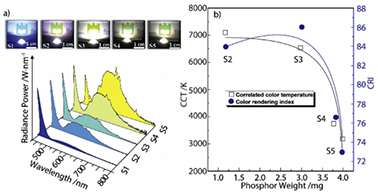
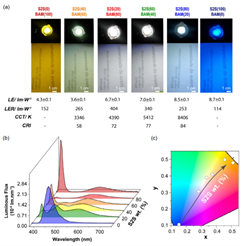
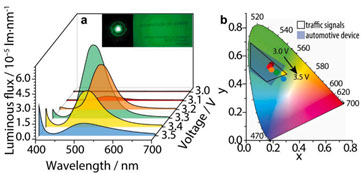
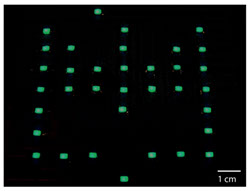
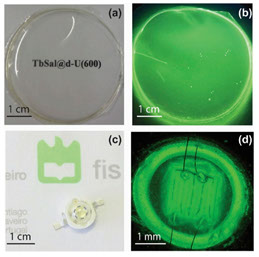

MADE BY PHANTOM-G, AVEIRO, PORTUGAL
